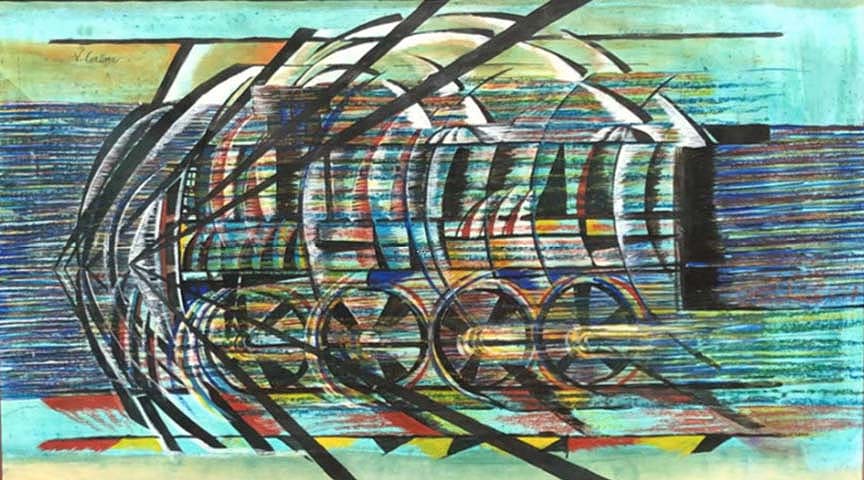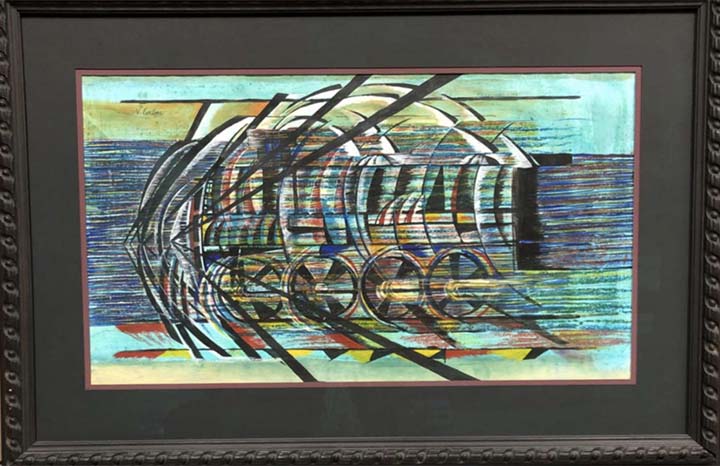

VITTORIO CORONA
"TRENO+VELOCITA"
TEMPORA, OIL, PASTEL, GOUACHE, SIGNED
ITALY, CIRCA 1920-1922
15.75 X 27.5 INCHES
PROVENANCE:
Estate of the Artist
Galleria Diomedea Arte, Palermo, Italy
Fuentes Fine Arts, Rome
Modernism Fine Arts Inc, New York

Vittorio Corona was an Italian Futurist painter whose early artistic education began in Palermo at the end of the 1910s, under the guidance of the painter Giovanni Varvaro.
At a very young age, Corona was introduced to exponents of Sicilian Futurism.
In 1922 he attended the Academy of Fine Arts in Palermo (design) and participated in the Youth Exhibition sponsored by the Permanent of Fine Arts receiving the silver medal for the painting “Dancers.”
During the same year, he was awarded the gold medal in the Exhibition of Fine Arts of Messina.
In 1924 Corona participated in the Exhibition of Young Artists at the Teatro Massimo in Palermo with a few paintings including the first version of “The Fall of the Stars”, “Riot” and “Earthly Deity.”
In 1925 he exhibited the final version of “The Fall of Stars” at the Spring Sicilian Art Exhibition in Palermo.
In the years between 1927 and 1930, he participated in the Great Exhibition of Futurist Painting in Bologna, the XVI International Art Exhibition in Venice, the Quadrennial in Turin, the Exhibition of Futurism in Genoa and the National Futurism Art Exhibition in Palermo.
In 1932 Corona left Palermo to accept the teaching chair at the Industrial Technical Institute of Vibo Valentia in Calabria and participated to the XIX International Venice Biennale.
His passion for teaching took him to the Technical Institute Principe di Piemonte in Meran (1937) and later and later to the Acqui Terme School; of Art.
The bombings of World War II destroyed his home in Palermo along with several futurist works, some of which had massive proportions. Immediately after the war he devoted himself mainly to oil painting.
In the 1950s the painter undertook the reconstruction of key Futurist works, destroyed during the bombardment of Palermo, by moving from the original sketches and reinterpreting them with a certain freedom, even in the size of the canvases.
He also finished works that were never completed starting from the original sketches.
In 1954 he held a solo exhibition at the Salone Grande Hotel Nuove Terme di Acqui, comprising about three hundred works (oils, gouaches, watercolors, drawings).
In 1956 he was a professor in Rome at the Art Institute. In 1956 he held a solo exhibition at the gallery in Via Advantage, with the warm and sincere presentation of Renato Guttuso, his former comrade in art.
Between 1963 and 1965 he created a series of works of neo-Futurist art that marked “a new commitment in the ways of the futurist tradition."
|